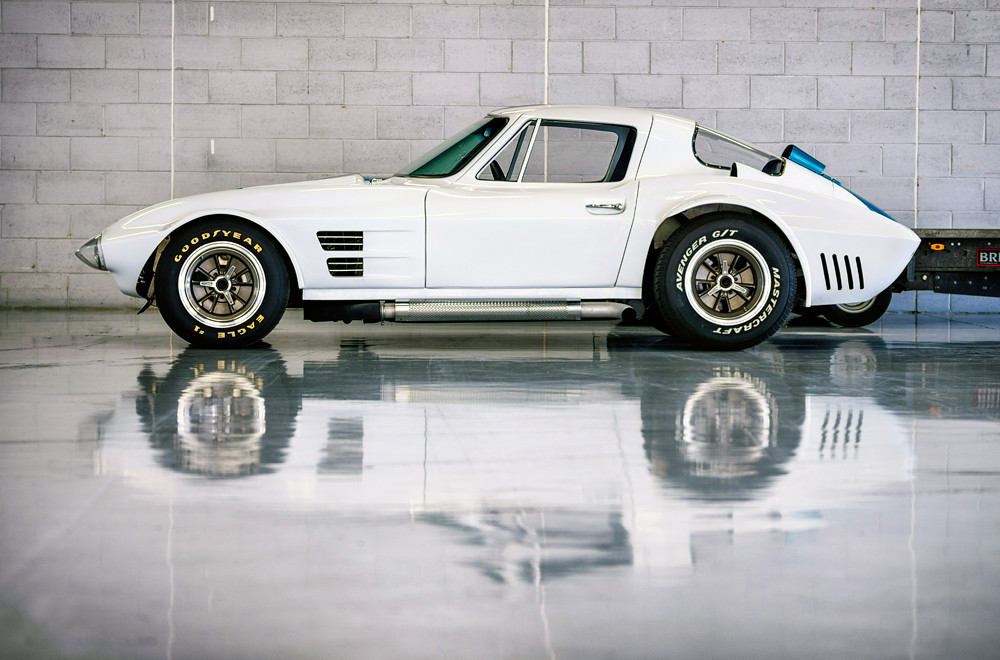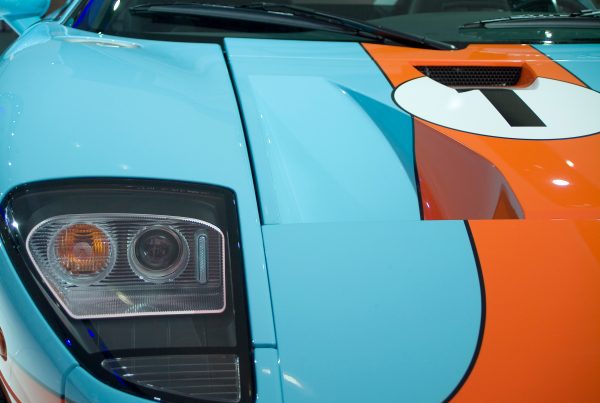Fast, Furious, and Built for High-Speed Action – the 1963 Corvette Grand Sport
Five.
That’s how many 1963 Corvette Grand Sport racers were built.
Only five. Making this ultra-light, high-performance powerhouse one of the rarest and most significant Chevrolets ever.
Outsize Personalities, Corporate Politics, Federal Regulation, Technical Prowess – All Figure in the Grand Sport Story
It started with a letter written in 1953 by Zora Arkus-Duntov. That was when Arkus-Duntov saw the first-generation Corvette at the General Motors Motorama and, impressed by the car’s beauty, took it upon himself to pen suggestions to Chevrolet chief engineer Ed Cole regarding how the roadster could be improved. Specifically, Arkus-Duntov, a European-trained racecar driver and automotive engineer of Russian heritage who had immigrated to the U.S. in 1941, said, audaciously, that the six-cylinder Blue Flame engine was underwhelming and the vehicle underpowered. Cole was so impressed he offered Duntov a job.
Rising quickly through the ranks, Arkus-Duntov championed Corvette and racing by pushing for increased performance and V8 engines. Appointed director of high-performance vehicles in 1957, Duntov-developed Corvettes made steady progress as racers – until everything stopped. That’s when General Motors, along with Ford and Chrysler, agreed to a 1957 ban imposed by the Automobile Manufacturers Association on organized auto racing and motorsports. The ban resulted in part from a catastrophic accident in 1955 during the 24 Hours of Le Mans that killed 83 spectators when a racecar exploded and flew into the crowd. By the early 1960s, GM bureaucrats were also concerned about the U.S. Justice Department taking antitrust action to break up the company if the market share reached 60 percent (it topped out at 53.). Stopping financial investment in motorsports was thought to be a way to cut visibility and slow sales growth. As a result, corporate support for racing halted for a number of years.
Not to be deterred, Arkus-Duntov continued to race cars through private teams and clandestine technical assistance. Duntov was particularly obsessed with the seemingly unbeatable Shelby Cobra. Developed by rival Carroll Shelby (another outsized personality of the era), the Ford-powered 289 Cobra dominated GT world championship racecourses throughout Europe and the U.S.
Duntov was forced to react by upping the technical ante, both to beat the Cobra and gain accolades for Corvette by winning on the international GT circuit.
Enter the 1963 Corvette Grand Sport, aka Project Lightweight
Despite corporate edicts, Arkus-Duntov pitched Chevrolet general manager Bunkie Knudsen on the development of a lighter Corvette based on the production Stingray, designated the Grand Sport. Knowing exactly what Duntov was up to, Knudsen provided unofficial assistance in the form of a black-ops budget and secret R&D site. A supporter of racing, Knudsen was as keen on beating the Shelby Cobra as Duntov was.
Since the primary goal was to remove as much weight as possible, the program was code-named Project Lightweight. Which perfectly describes the 1963 Grand Sport.
Tipping the scales at just 1,900 lbs., Grand Sport was 1,000 lbs. lighter than the production Stingray, and more importantly, 300-400 lbs. less than a competitor Cobra. Such extreme weight reduction was achieved in several ways, including the use of paper-thin fiberglass panels, hand-built aluminum and magnesium components, and a rigid, super-light, round steel twin-tube frame with a built-in roll bar.
Other racing-focused features: an aluminum block 377 CID V8 engine that developed 550 horsepower, 58mm Weber carbs, front suspension with thinner A-arms and aluminum steering box, aluminum differential rear suspension and drilled control arms, Girling solid disc brakes with solid rotors, and Halibrand magnesium wheels circled by Firestone racing tires. Specialized air management was provided by the tapered roofline and windshield, hard-edged styling, plexi-covered highlights built into the body, turn signals integrated with the grille area, hood extractor, and air intakes, and venting strategically placed in front and rear fenders and between taillights. The spartan interior was all-fiberglass, with blue carpet, a teak-wood steering wheel, and only two extra gauges – for differential and engine oil temperature. Determined to best the Shelby Cobra, Arkus-Duntov insisted on equipping Grand Sport with a go-the-distance 36-gallon fuel tank.
Nassau Speed Week 1963 Proved the Concept. Competitors – and GM Brass – Noticed
Eager to test his racer against the much-heralded Shelby Cobra in real-world competition, Duntov sent three Grand Sports to Nassau Speed Week in August 1963. Held in Nassau, Bahamas, from 1954 through 1966, this weeklong bacchanal combined hard-charging motorsports with serious partying as teams from every major manufacturer showcased their speed and expertise. Going head-to-head in the Governor’s Cup Race (its first and only official outing on a racetrack), Grand Sport triumphed, decisively proving Shelby’s Cobras were beatable, and while they were at it, embarrassing several major European marques. Whooping it up on the sidelines – a number of Chevrolet engineers who found themselves vacationing in Nassau that week.
But Grand Sport’s glory was short-lived. GM powers-that-be soon learned of the car’s exploits, promptly terminated the project, and made plans to destroy the five units that had been built. Duntov quickly transferred the cars to private buyers, some of whom made modifications and continued to race the vehicles for several years.
Considered the “godfather of the Chevrolet Corvette”, Zora Arkus-Duntov is credited with transforming the underwhelming 1953 attraction into today’s world-class sports car. That the 1963 Grand Sport was an important milestone in that journey is without dispute. Commenting on the historic 1963 encounter in Nassau, rival Carroll Shelby said simply, “We were outgunned.” On other occasions, he noted that because of corporate interference, Duntov “accomplished only about 25 percent of what he was capable of,” adding “the original Grand Sport is the great Corvette racer that never was.” Legendary driver A.J. Foyt marveled at Grand Sport’s acceleration from the cockpit of a 500-horsepower Ford prototype: “It went by me like I was stopped.”
And yes, the car appeared in the Fast and Furious movie franchise, saving the good guys in, appropriately enough, 2011’s Fast Five. Five replica cars were built for the occasion.
Amazingly, all five of the original Grand Sports survive as museum displays or in private collections. Occasionally they’re seen in public during exhibits like the 2003 Amelia Island Concours d’Elegance when the five appeared together. From time to time, the Simeone Foundation Automotive Museum in Philadelphia treats enthusiasts attending a Demo Days event to an original Grand Sport drive-by. In the unlikely event that one comes up for sale, expect a $6 to $8 million price tag to be attached. The wondrous 1963 Grand Sport racing machine is truly one of the greatest Corvettes of all time.



